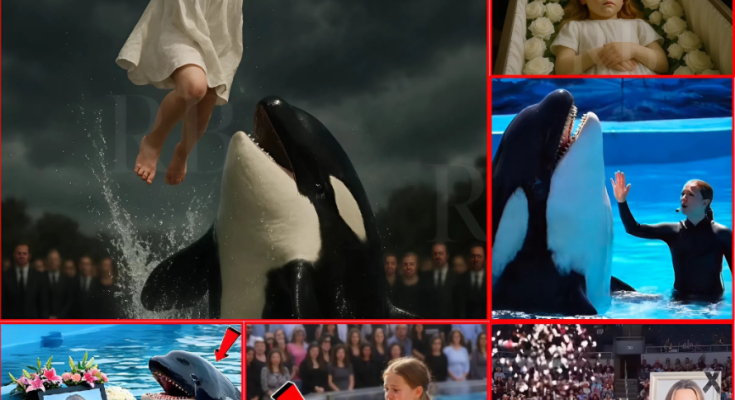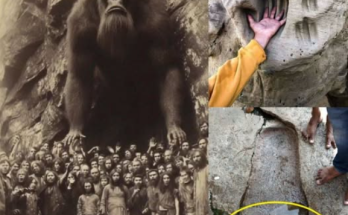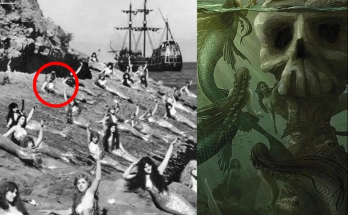What was meant to be a somber farewell turned into one of the most shocking and disturbing spectacles ever witnessed at a marine memorial. Hundreds gathered on a gray afternoon to honor Marina Caldwell, a beloved orca trainer who tragically lost her life during a rehearsal accident months earlier. Family, friends, and supporters packed into the memorial arena, their eyes misty with grief, their hearts prepared to relive tender memories.
But within moments, mourning gave way to mayhem. As her young daughter approached the water’s edge to place flowers for her late mother, an orca surged violently from the pool. The massive creature collided with the platform, sending the child hurtling into the stunned crowd. Screams rang out, security scrambled, and what was meant to be a respectful tribute became an unforgettable scene of panic, confusion, and horror.
The incident has since gone viral, raising urgent questions about human-animal bonds, the risks of memorializing trainers inside marine parks, and whether keeping orcas in captivity has reached a moral and cultural breaking point.
The Build-Up to the Farewell
The farewell for Marina Caldwell was carefully planned. Organizers hoped to blend solemn reflection with symbolic gestures. Colleagues prepared video montages, family members wrote letters to be read aloud, and fellow trainers stood ready to share anecdotes about her fearless spirit.
The centerpiece of the ceremony was to be a moment of connection: Marina’s daughter, Lily, laying a bouquet of white lilies — her mother’s favorite — at the very edge of the orca pool. Trainers assured guests that the orcas, familiar with memorial rituals, would remain calm and respectful.
For 45 minutes, the memorial unfolded smoothly. Attendees wept during speeches. Old training footage projected onto large screens brought both smiles and sobs. The atmosphere was heavy with sorrow but united in remembrance.
Then came the final act.
The Orca’s Surge
As Lily approached the pool, the air grew still. Many guests instinctively leaned forward, cameras and phones ready. Trainers guided the child with careful precision.
But without warning, Titan, the largest of the orcas, burst upward from the water. The sound was like an explosion — gallons of water drenching the front rows. Witnesses described the creature’s body rising with terrifying force, its 8,000-pound mass colliding with the edge of the platform.
The impact knocked Lily off balance. Screams pierced the silence as the child was launched into the front rows, crashing into a cluster of mourners. Chaos erupted. Guests scrambled, some shielding children, others frozen in shock.
Within seconds, staff rushed to secure the orca while paramedics swarmed the stands. Lily, shaken but alive, was quickly taken to safety.
Eyewitness Reactions

The audience described the scene as surreal, almost cinematic.
-
“One moment it was tears of grief, the next it was pandemonium. I couldn’t believe what I was seeing,” said Sarah Lopez, a longtime family friend.
Family games -
“The whale’s roar of water sounded like a cannon blast. People screamed like it was an earthquake,” recalled another mourner.
-
Videos recorded by attendees went viral within hours, replayed endlessly on TikTok, Twitter, and news broadcasts.
The clip — grainy but undeniable — showed the exact moment Titan surged, the child flying into the air, and the crowd recoiling in horror.
The Fallout
Family Response
Marina’s husband, Thomas Caldwell, spoke briefly after the chaos:
“This was meant to honor Marina’s memory, not replay the tragedy of her work. We are grateful Lily is safe, but we ask — how many times must orcas show us that they cannot be controlled?”
Marine Park Response
The marine park issued a statement within hours:
“We are deeply saddened by the incident that occurred during today’s memorial. Our priority is the safety of all guests and animals. An investigation is underway.”
Yet critics accused the park of negligence, saying no memorial should ever have placed a child near an unpredictable animal.
Experts Weigh In
Marine Biologists
Dr. Hannah Price, an orca specialist, explained:
“Orcas are intelligent but unpredictable. The stress of captivity often triggers sudden outbursts. Memorial ceremonies may trigger memories or emotions we cannot fully understand.”
Psychologists
Dr. Emily Shore noted:
“The symbolism of a grieving child near her mother’s training animal may have been well-intentioned but psychologically dangerous. Animals react to energy, sound, and movement. This orca may have sensed distress.”
Trainers
Some former trainers defended Titan, saying the surge was not aggression but instinctive behavior. Others insisted the incident proved orcas do not belong in captivity at all.
Public Reaction

The fallout was instant.
Outrage
Animal rights groups blasted the memorial. One viral post read: “A memorial turned into another tragedy. End orca captivity now.”
Support
Others expressed sympathy for the family and urged compassion: “This wasn’t malice. It was a tragedy of circumstance. The whale is not a villain.”
Division
The incident reignited debates over marine parks. Some fans insisted the orcas were family to trainers like Marina. Others argued that no memorial should take place in a facility tied to her death.
Social Media Firestorm
Clips of the surge flooded TikTok and Twitter, viewed over 100 million times in 24 hours.
-
Memes mocked the park’s slogan: “Safe. Educational. Inspiring.” replaced with “Scary. Explosive. Inexcusable.”
Family games -
Others created somber montages calling for #JusticeForMarina and #FreedomForTitan.
-
Hashtags like #OrcaMemorial, #TitanSurge, and #StopCaptivity trended worldwide.
International Headlines
The incident dominated global coverage.
-
BBC: “Memorial Chaos: Orca Surges at Ceremony, Child Injured in Crowd.”
-
Le Monde (France): “From Tribute to Trauma: When a Memorial for a Trainer Becomes a Scene of Panic.”
-
Global Times (China): “America’s Obsession With Entertainment Turns to Tragedy Again.”
The Broader Debate
The memorial mayhem reignited old debates with new urgency:
-
Animal Rights: Should orcas ever be kept in captivity?
-
Ethics of Memorials: Was it appropriate to involve the animals in a trainer’s farewell?
-
Cultural Symbolism: Did the orca’s surge represent defiance — a wild creature reminding humans of its untamed nature?
Possible Futures
-
Policy Change: The marine park may end public orca shows altogether, focusing on rehabilitation.
-
Public Backlash: Attendance may plummet, as families fear future accidents.
Family games -
Reform Movement: The tragedy could energize global campaigns to ban marine mammal captivity.
Conclusion
What began as a solemn farewell to a beloved trainer became one of the most shocking scenes ever witnessed in a marine park. A grieving daughter, a massive orca, and a crowd of mourners collided in chaos that will not soon be forgotten.
For Marina Caldwell’s family, the tragedy compounds their grief. For activists, it is proof that captivity is unsustainable. For the public, it is a haunting reminder: the boundary between human ceremony and animal instinct is fragile, unpredictable, and sometimes catastrophic.
As the debate continues, one truth remains clear: memorials are meant to bring closure. Instead, this one opened new wounds — for a family, for a community, and perhaps for an entire industry.



